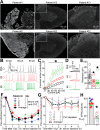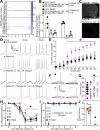Anti-CV2/CRMP5 autoantibodies as drivers of sensory neuron excitability and pain in rats
- PMID: 40775229
- PMCID: PMC12332130
- DOI: 10.1038/s41467-025-62380-y
Anti-CV2/CRMP5 autoantibodies as drivers of sensory neuron excitability and pain in rats
Abstract
Paraneoplastic neurological syndromes arise from autoimmune reactions against nervous system antigens due to a maladaptive immune response to a peripheral cancer. Patients with small cell lung carcinoma or malignant thymoma can develop an autoimmune response against the CV2/collapsin response mediator protein 5 (CRMP5) antigen, with approximately 80% of these patients experiencing painful neuropathies. Here we investigate the mechanisms underlying anti-CV2/CRMP5 autoantibodies (CV2/CRMP5-Abs)-related pain and find that patient-derived CV2/CRMP5-Abs bind to their target on rat dorsal root ganglia (DRG) and superficial laminae of the spinal cord, to induce DRG neuron hyperexcitability and mechanical hypersensitivity. These effects from patient-derived Abs are recapitulated in rats immunized with a DNA vaccine for CRMP5, in which therapeutic treatment with anti-CD20 depleting B cells ameliorates autoimmunity and neuropathy. Our data thus reveal a mechanism of neuropathic pain in patients with paraneoplastic neurological syndromes and implicates CV2/CRMP5-Abs as a potential target for treating paraneoplastic neurological syndromes.
© 2025. The Author(s).
Conflict of interest statement
Competing interests: The authors declare no competing interests.
Figures




Update of
-
Mechanism, and treatment of anti-CV2/CRMP5 autoimmune pain.bioRxiv [Preprint]. 2024 May 7:2024.05.04.592533. doi: 10.1101/2024.05.04.592533. bioRxiv. 2024. Update in: Nat Commun. 2025 Aug 7;16(1):7311. doi: 10.1038/s41467-025-62380-y. PMID: 38766071 Free PMC article. Updated. Preprint.
References
-
- Dubey, D. et al. Autoimmune CRMP5 neuropathy phenotype and outcome defined from 105 cases. Neurology90, e103–e110 (2018). - PubMed
-
- Dubey, D. et al. Amphiphysin-IgG autoimmune neuropathy: a recognizable clinicopathologic syndrome. Neurology93, e1873–e1880 (2019). - PubMed
-
- Antoine, J. C. et al. Paraneoplastic anti-CV2 antibodies react with peripheral nerve and are associated with a mixed axonal and demyelinating peripheral neuropathy. Ann. Neurol.49, 214–221 (2001). - PubMed
-
- Honnorat, J. et al. Ulip/CRMP proteins are recognized by autoantibodies in paraneoplastic neurological syndromes. Eur. J. Neurosci.11, 4226–4232 (1999). - PubMed
MeSH terms
Substances
Grants and funding
- R01 DA042852/DA/NIDA NIH HHS/United States
- R01NS119263/U.S. Department of Health & Human Services | NIH | National Institute of Neurological Disorders and Stroke (NINDS)
- R01NS120663/U.S. Department of Health & Human Services | NIH | National Institute of Neurological Disorders and Stroke (NINDS)
- R01 NS098772/NS/NINDS NIH HHS/United States
- R01 NS119263/NS/NINDS NIH HHS/United States
LinkOut - more resources
Full Text Sources

